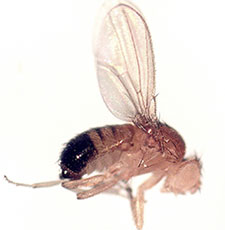Discovery of Fruit Fly Model Could Help Stroke and Transplant Patients
December 7, 2007
By Kim McDonald

Fruit Fly
Biologists have discovered that the common fruit fly is an ideal laboratory model for reperfusion injury-a physiological condition that occurs when an organ is starved of oxygen, then exposed to oxygen again, and which can lead to death among stroke victims and during organ transplants.
Researchers at UC San Diego and the University of Nevada at Las Vegas, who report their discovery in the December 5 issue of the journal Public Library of Science One, said that because reperfusion injury can be induced in fruit flies, scientists will now have a convenient, inexpensive and well-characterized animal model for this physiological condition.
"This is the first physiological demonstration of reperfusion damage in an invertebrate," said Pablo Schilman, a lecturer in UCSD's Division of Biological Sciences who made the discovery with John Lighton, an adjunct professor of biological sciences at UNLV.
"With this new model, researchers can explore the mechanisms of reperfusion injury with a classic animal model that's much cheaper and easier to use than vertebrates such as mammals," said Lighton, president of Sable Systems International, a Nevada based company that manufactures precision respirometry systems, who headed the study. "Use of this method creates a window into the cells' mitochondria. Using Drosophila as a model may mean faster progress in mitigating the human toll of reperfusion injury, which we still don't fully understand. And what we don't fully understand, we can't treat effectively."
The study, which was funded by Sable Systems International's Basic Research Initiative and took place in Sable Systems' respirometry laboratory in Las Vegas, started out with the first detailed metabolic examination of the fruit-fly's ability to survive a complete lack of oxygen for an hour or more.
"By accident," said Lighton, "we discovered that exposing fruit-flies to one or more brief bursts of oxygen while they were otherwise oxygen-starved, injured their respiratory systems irreversibly-classic reperfusion injury."
Lighton and Schilman tracked damage to the flies' respiratory systems by measuring the water vapor and carbon dioxide lost by individual flies weighing less than a thousandth of a gram. The carbon dioxide output provided an index of mitochondrial activity, while respiratory water loss tracked the functional state of the fly's neuromuscular system.
"We now have ways of measuring reperfusion injury in Drosophila," said Lighton. "So, it's possible both to improve our understanding of the process and to test strategies for mitigating it using an animal most people don't have an emotional reaction to, other than a desire to swat it. We hope that biomedical researchers will pick up on this opportunity."
Read Oxygen Reperfusion Damage in an Insect online.
Media Contact: Kim McDonald, UCSD 858-534-7572
Comment: John Lighton, UNLV 702-269-4445 Pablo Schilman, UCSD
